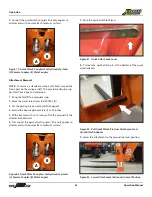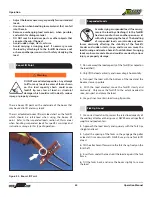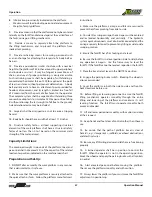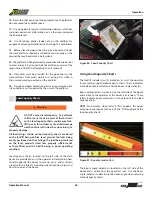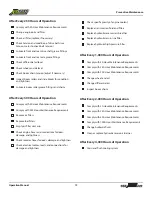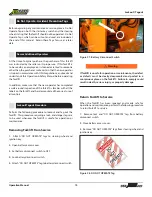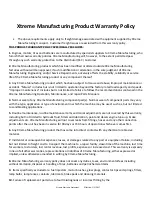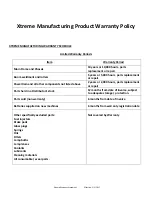
Operation Manual
67
Operation
8.
Information prominently indicated on the platform;
•
Maximum work load including personnel and equipment.
•
Weight of empty platform.
9.
Provide a means so that the platform can only be centered
laterally on the forklift and retained against the vertical face of
the forks, carriage, or lifting mechanism.
10.
Provide a means to securely attach the platform to
the lifting mechanism, and to prevent the platform from
inadvertent pivoting.
11.
Provide restraining means for securing personnel such
as an anchorage for attaching the lanyard of a body belt or
harness.
12.
Provide a guardrail or similar structure with a nominal
height to the platform of 42 inches around its upper periphery
and include a mid rail. It may be hinged, removable, or of
chains, and used if proper positioning is easily discernible.
Such restraining means shall be capable of withstanding a
concentrated horizontal force of 200 lbs applied at the point
of least resistance without permanent deformation. A body
belt and lanyard is to have an attachment point provided for
freedom of movement, and its length is limited to a free-fall
of 5’ measured from the point of attachment to the operator.
The complete system shall be capable of withstanding three
consecutive drop tests to simulate a 250 lbs person free falling
6’ without allowing the test weight to fall free to the ground.
A deceleration device may be included.
13.
Lanyards shall be arranged so as not to cause a tripping
hazard.
14.
Body belts should have a width of at least 1.75 inches.
15.
Structural safety factor - all load supporting structural
elements of the work platform shall have a structural safety
factor of not less than 2-to-1 based on the minimum yield
strength of the material used.
Capacity Limitations:
The combined weight in pounds of the platform, load, and
personnel shall not exceed 33% of the capacity of the related
load center position indicated on the machine load chart.
Preparation and Set-Up:
1.
DO NOT
alter or modify the work platform in any manner
that is detrimental to its safe use.
2.
Make sure that the work platform is securely attached to
the quick attach or forks. Follow the platform manufacturer’s
instructions.
3.
Make sure the platform, carriage, and forks are secured to
prevent them from pivoting from side to side.
4.
On side tilt or swing carriage, the carriage must be centered
and/or leveled horizontally and vertically. The hydraulic
system quick disconnects must also be disconnected and the
carriage securely fastened to prevent any tilting or side to side
swinging motion.
5.
Ensure the forklift has a firm footing and is level.
6.
Be sure the forklift is in a level position (side to side) before
any operation is begun. Use the frame sway to level the
forklift. If the forklift cannot be leveled, reposition the forklift.
7.
Place the travel select lever in the NEUTRAL position.
8.
Engage the parking brake switch. Blocking the wheels is
also recommended.
9.
Level the platform in both the side-to-side and front-to-
back directions before use.
10.
Before lifting or lowering personnel, be sure the forklift
lifting mechanism operates smoothly through the entire
lifting and lowering of the platform and maintains its self-
leveling function. The forklift must operate smoothly both
empty and loaded.
11.
Lift and lower personnel smoothly, with caution, and only
at their request.
12.
Keep hands and feet clear of controls other than those in
use.
13.
Be certain that the path of platform travel is clear of
hazards, e.g., storage racks, scaffolds, overhead obstructions,
and electrical wires.
14.
Be sure any lift limiting devices and latches are functioning
properly.
15.
A trained operator shall be in position to control the
forklift. When the operator is not in the operating position,
block the wheels and apply the parking brake with all controls
in neutral.
16.
Alert elevated personnel before moving the platform.
Then move the platform smoothly and with caution.
17.
Always lower the platform if you must move the forklift for
adjustment in positioning.











